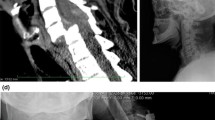Abstract
Introduction
Surgical management of upper cervical spine (UCS) unstable injuries may be challenging as the number of cases requiring this surgery collected in every single center is small. This retrospective study was conducted to analyze the radiographic and clinical results in 12 patients undergoing a posterior occipito-cervical fusion by a polyaxial screws–rod–plate system.
Methods
There were eight male and four female patients with a mean age of 73.7 years (range 32–89 years). Six patients presented neurologic deficits at admission. Six patients had sustained major trauma. The remaining six patients had suffered a minor trauma.
Results
Two patients died postoperatively in Intensive Care Unit. All surviving patients achieved solid fusion at 6 months. No surviving patient had neurological deterioration postoperatively. There were no instrumentation failures or revision required. Two patients suffered from superficial occipital wound infection.
Conclusions
Although the indication to occipito-cervical fusion decreased since the new C1–C2 posterior fixation techniques were described, it remains a valid and reliable option in UCS post-traumatic instability to be applied even in emergency especially in the elderly.


Similar content being viewed by others
References
Lee SC, Chen JF, Lee ST (2006) Clinical experience with rigid occipitocervical fusion in the management of traumatic upper cervical spinal instability. J Clin Neurosci 13(2):193–198
Abumi K, Takada T, Shono Y, Kaneda K, Fujiya M (1999) Posterior occipitocervical reconstruction using cervical pedicle screws and platerod systems. Spine 24:1425–1434
Lu DC, Roeser AC, Mummaneni VP, Mummaneni PV (2010) Nuances of occipitocervical fixation. Neurosurgery 66(Suppl 3):141–146
Wang JC, Mummaneni PV, Haid RW Jr (2008) Fixation options in the occipitocervical junction. In: Mummaneni PV, Lenke LG, Haid RW Jr (eds) Spinal deformity: a guide to surgical planning and management. Quality Medical Publishing, St Louis, pp 223–240
Papadopoulos SM, Dickman C, Sonntag VKH, Rekate HL, Spetzler RF (1991) Traumatic atlantooccipital dislocation with survival. Neurosurgery 28:574–579
Malik SA, Murphy M, Connolly P, O’Byrne J (2008) Evaluation of morbidity, mortality and outcome following cervical spine injuries in elderly patients. Eur Spine J 17(4):585–591
Johnson RM, Hart DL, Simmons EF, Ramsby GR, Southwick WO (1977) Cervical orthosis; a study comparing their effectiveness in restricting cervical motion in normal subjects. J Bone Jt Surg (Am) 59A:332–339
Lomoschitz FM, Blackmore CC, Mirza SK, Mann FA (2002) Cervical spine injuries in patients 65 years old and older. AJR 178:573–577
Lieberman IH, Webb JK (1998) Occipito-cervical fusion using posterior titanium plates. Eur Spine J 7(4):308–312
Finn MA, Bishop FS, Dailey AT (2008) Surgical treatment of occipitocervical instability. Neurosurgery 63(5):961–968
Greene KA, Dickman CA, Marciano FF, Drabier J, Hadley MN, Sonntag VKH (1997) Acute axis fractures: analysis of management and outcome in 340 consecutive cases. Spine 22:1843–1852
Hadley MN, Browner C, Sonntag VKH (1985) Miscellaneous fractures of the second cervical vertebra. BHI Q 1:34–39
Majercik S, Tashjian RZ, Biffl WL, Harrington DT, Cioffi WG (2005) Halo vest immobilization in the elderly: a death sentence? J Trauma 59(2):350–356
Tashjian RZ, Majercik S, Biffl WL, Palumbo MA, Cioffi WG (2006) Halo-vest immobilization increases early morbidity and mortality in elderly odontoid fractures. J Trauma 60(1):199–203
Vaccaro AR, Lim MR, Lee JY (2005) Indications for surgery and stabilization techniques of the occipito-cervical junction. Injury 36(Suppl 2):B44–B53
Steinmetz MP, Mroz TE, Benzel EC (2010) Craniovertebral junction: biomechanical considerations. Neurosurgery 66(Suppl 3):7–12
Conflict of interest
None.
Author information
Authors and Affiliations
Corresponding author
Rights and permissions
About this article
Cite this article
Cappuccio, M., De Iure, F., Amendola, L. et al. Occipito-cervical fusion in post-traumatic instability of the upper cervical spine and cranio-cervical junction. Eur Spine J 22 (Suppl 6), 900–904 (2013). https://doi.org/10.1007/s00586-013-3015-y
Received:
Revised:
Accepted:
Published:
Issue Date:
DOI: https://doi.org/10.1007/s00586-013-3015-y




